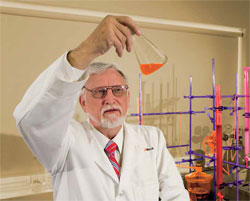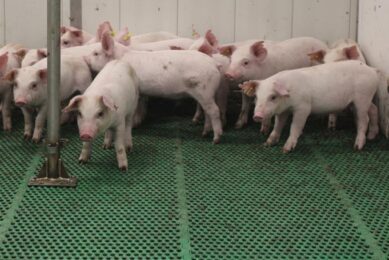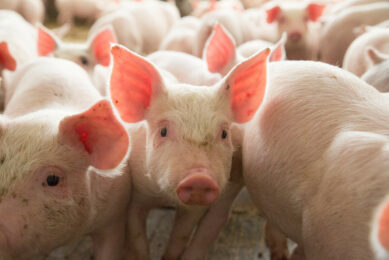A primacy in science and education – Part 1. Total replacement makes green sense

Research and education have helped agriculture move forward over the last 30 years. In this period of time, more has changed in pig husbandry than in thousands of years prior to that. This series aims to uncover some of the most essential and fundamental changes that happened and casts a look forward as to how science can help improve agriculture even further in the years to come. Improving sow productivity has been targeted as one of the key factors in improving pig production efficiency. A back drop to this target is the increasing concern about the environmental impact of intensive pig production, with nutrient management systems a future challenge for all producers. Solutions must not only enable improvements but allow the producer to do so economically.
By Patrick Charlton, European regional director, Alltech & Dr Lode Nollet, solutions deployment team, Alltech
The pork industry in most countries continues to face many challenges, including often large fluctuations in profitability and hence security. This is despite there being more pork consumed in the world than any other meat. While the world demand for pork is expected to increase, especially with the improved standard of living in many developing countries, competition for these markets will be high. The industry is hence driven by a need to improve efficiency, lower the cost of production and to produce a product that meets the expectations of the consumer. Those producers and/ or countries that will continue to be involved in pig production will be those that are prepared to evaluate and adopt new technologies to remain competitive in an increasingly global market.
In spite of the significant developments in understanding modern genetic requirements for most nutrients, including protein, amino acids and energy, our current scientific data supporting trace mineral supplementation is simply outdated. Today’s supplemental trace mineral levels bare little association to the NRC published requirements as seen in Table 1.
Environmental impact
Very little concern has historically been given to trace mineral excretion levels, however with the political landscape changing quickly and the green environmental agenda front and centre globally, this topic is certain to have a significant impact on levels and forms of trace minerals fed.
The heavy metal contents of farm manures are largely a reflection of their concentrations in the feeds consumed and the efficiency of retention of these nutrients by the animals. Fleming and Mordenti (1991) reported a mean zinc concentration in Belgian pig manures of 919 mg/kg (dry matter). However, Menzi and Kessler (1998) generally found 554 to 747 mg Zn/kg DM in Swiss pig manure. Copper concentrations in pig manures were much higher in Belgian manures (574 mg) than in Swiss manures (71 to 119 mg Cu/kg DM). These ranges, like those found in the literature, are extremely broad and clearly dependent to a large extent on the age of the pigs and the quantities of zinc and copper supplements added to the diet.
In order to protect environmental quality and safety, the European Commission is preparing a new directive designed to reduce the mineral loading on farmland. The result will be that maximum mineral levels allowed will be lower than presently used. Although there has not yet been a final decision on allowed levels, they will probably be close to the normal content of feedstuffs with supplementation minimal. These changes will make the introduction of more available forms a necessity to meet animal requirements.
Organic mineral technology
The issue is not just a European one with governments around the world closely monitoring the environmental impact of agriculture, and specifically livestock production.
This focus led to leading Australian pig producer, Rivalea Australia, to investigate the opportunity to harness the improved availability of organic copper (in this case Bioplex, Alltech) to minimise feeding levels and ultimately excretion in line with Australian EPA (Environmental Protection Agency) directives.In the first experiment cited, two levels of copper sulphate (20 ppm and 220 ppm) or organic copper (100 ppm) were fed in grower-finisher diets to male pigs from 28 kg to slaughter. The performance data showed that the treatments with either, organic copper or the higher level of copper sulphate improved growth rates by 5%, and feed conversion by 3%. There was no significant difference in performance between diets containing organic copper and the higher level of copper sulphate, as well as no differences in carcass characteristics (weight, P2 fat thickness, and dressing percentages), although the organic copper fed pigs were numerically superior. The researchers said that their results only confirmed that alternative forms of copper can be utilised to maintain performance whilst minimising copper excretion.
Second experiment
In a similar second experiment, the same organic copper product was shown to reduce the amount of copper excreted by pigs. This time, a basal diet was set up, followed by the addition of 160 ppm copper (copper sulphate) or 50 ppm (organic copper). Table 2 shows, there was an approximate 47% reduction in the faecal copper content excreted by both male and female groups fed the organic copper diets.
It was concluded that the reduction in these final copper effluent levels indicates that organic minerals can be added at much lower dietary levels than inorganic copper without adversely affecting growth parameters, but can significantly decrease trace mineral excretion. There was also some speculation that further study could record similar results with other trace minerals commonly formulated in pig rations.
Improved performance benefits
Fluctuating profitability in the pig industry makes subsidising environmental programmes difficult, especially if the end consumer is not willing to pay a premium for this. Consequently scientists have also focused their research on optimising animal mineral status with a view to improving animal performance.
This response is best illustrated in the research conducted by Peters and Mahan (Ohio State University), where high producing sows were fed trace minerals in two different forms (inorganic or organic) and two different levels (NRC or industry). The data from this study highlight not only the marked improvement in sow productivity when the organic forms were fed but also a negative impact of feeding increasing levels of inorganic trace minerals to sows.
No mode of action has been defined for this effect, but similar responses have been seen in other species. Global interest in this redefining mineral requirement programme has led to widespread testing and uptake of this technology on a commercial scale.











